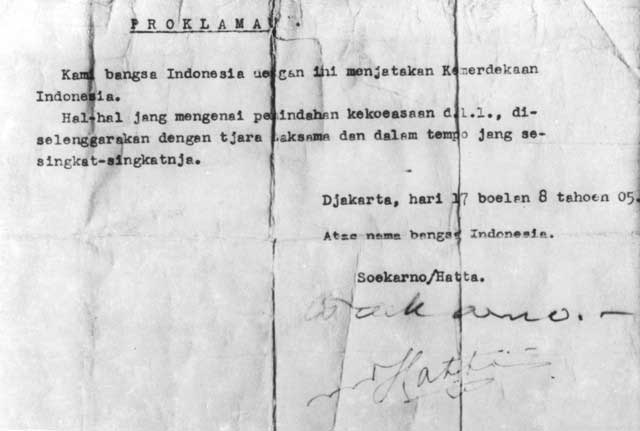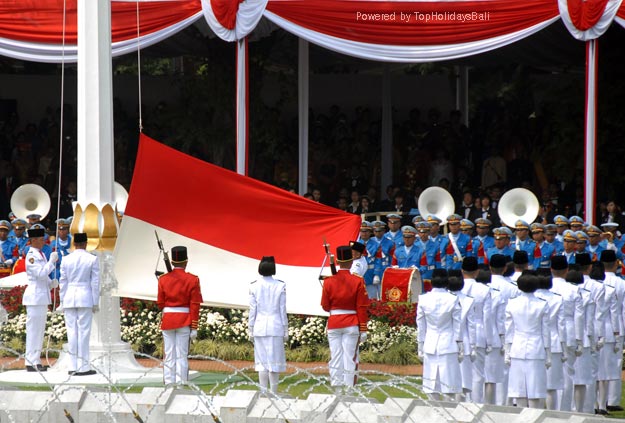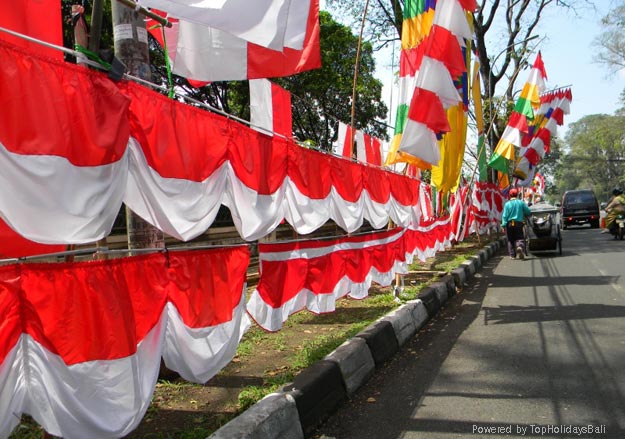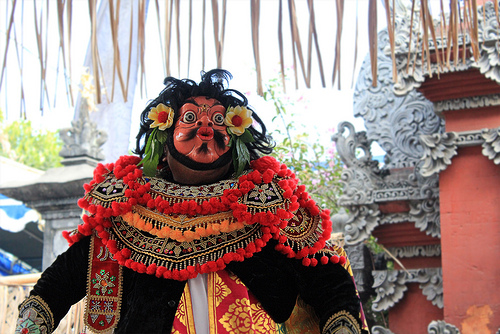Friday, 17 August 1945 was the most historical day for all Indonesian people, when Ir. Soekarno proclaimed the Indonesia Independence Day. After being under Dutch colonialism for more than three and half century and Japanese colonialism for three and half years, the people of Indonesia finally achieved their aspiration to become an independence nation.
Following are the highlights of Indonesia’s long historical journey, since the Dutch Colonialism until the proclamation of Indonesia’s Independence.
The Beginning of Dutch Colonialism
In their search for spices, the Portuguese arrived in Indonesia in 1511, followed by the Spaniards. Later, the Dutch also started their search for spices in Indonesia, which they sold in European markets with big profits, and established the Dutch East India Company (VOC) in 1602.
In 1605, Dutch colonialism began to have a foothold over Indonesian territories. The capital of Sunda Kelapa was named “Batavia” by the Dutch.
War Against the Dutch
Sultan Hasanuddin of Goa fought a war against the Dutch in 1666, but he was defeated. Prince Trunojoyo of Madura also fought the Dutch. He was defeated and killed in 1680. In 1740, the Dutch suppressed a rebellion in Jakarta that was sparked by dissatisfied Chinese, who were later joined by Indonesians. Ten thousand Chinese were killed.
British Temporary Rule
In 1714, the British came to Indonesia and built Fort York in Bengkulu on the west coast of Sumatera which was later renamed Fort Marlborough. The British stayed in Bengkulu until 1825.
During the Napoleonic wars in Europe when Holland was occupied by France, Indonesia fell under the rule of the British East India Company (1811-1816). Sir Thomas Stanford Raffles was appointed Lieutenant Governor General of Java and dependencies.
After the fall of Napoleon, and the end of the French occupation of Holland, the British and Dutch signed a convention in London on 13 August 1814, in which it was agreed that Dutch colonial possessions dating from 1803 onwards should be returned to the Dutch Administration in Batavia. Thus, the Batavian Republic reclaimed the Indonesian archipelago from the British in 1815.
Return of Dutch Colonialism
Soon the Dutch strengthened their colonial rule. But this only sparked rebellions to seize freedom. Thomas Matulessy (Pattimura) staged a revolt against the Dutch in the Moluccas (1816-1818). Prince Diponegoro of Mataram led a fierce struggle for freedom which was known as the Java War from 1825-1830. Tuanku Imam Bonjol led the Padri War in West Sumatera, while Teuku Umar headed the Aceh War in North Sumatera (1873-1903). King Sisingamangaraja of the Bataks revolved against the Dutch in 1907. An attempt by the Dutch troops to occupy Bali in 1908 was repelled by King Udayana. Revolts were also erupting in Goa, South Sulawesi, and in South Kalimantan.
Nationalist Movements
When all those regional wars of independence failed, Indonesian nationalists began thinking of a more organized struggle against Dutch colonialism. The move began with the founding of Boedi Oetomo by Dr. Soetomo on 20 May 1908. This organization of Indonesian intellectuals was initially set up for educational purposes but later turned into politics.
In 1911, Sarekat Dagang Islam (the Society of Moslem Entrepreneurs) was formed by Haji Samanhudi and others. Its objective was at first to motivate and to promote Indonesian business in the Dutch East Indies. However, in 1912, this organization turned into a political party and was renamed Sarekat Islam.
In December 1912, Partai Indonesia was founded by Douwes Dekker with Dr. Tjipto Mangunkusumo and Ki Hajar Dewantoro (Suwardi Suryaningrat). The aim of the party was to strive for complete independence of Indonesia. All three leaders of the party were exiled by the colonial government in 1913.
In 1924, Perhimpunan Mahasiswa Indonesia (the Indonesian Students Association) was formed by Drs. Mohammad Hatta, Dr. Sukiman and others. This organization became a driving force of the nationalist movement to gain independence.
On 28 October 1928, delegates to Indonesian Youth Congress in Jakarta pledged commitment to One Nation, One Motherland and One Language. The “Indonesia Raya” song was introduced for the first time at the 2nd Indonesian Youth Congress by its composer, Wage Rudolf Supratman.
In December 1929, the Dutch colonial authorities arrested Ir. Soekarno which touched off widespread protests by Indonesians. In 1934, Drs. Mohammad Hatta, Sutan Syahrir and other nationalist leaders were arrested by the Dutch and sent into exile.
The Japanese Occupation
After the Japanese attacks of Pearl Harbor in Hawaii, Japanese Armed Forces occupied several Southeast Asian countries. After the fall of Singapore, Japanese invaded the Dutch East Indies and the Dutch colonial army surrendered in March 1942. Soekarno and Hatta were released from their detention.
Due to the hardships suffered by the Japanese caused by Indonesian rebellions, the Japanese occupation forces in Indonesia finally gave in to recognize the Indonesian Red and White colored flag as the Indonesian national flag, which was followed by the recognition of “Indonesia Raya” as the national anthem and Bahasa Indonesia as the national language.
Proclamation
The final defeat of Japan after the dropping of the atomic bomb in Hiroshima and Nagasaki on the 6th and 9th of August 1945 prompted the Japanese to surrender unconditionally to the Allies. This constitutes an ample opportunity for Ir. Soekarno and Drs. Mohammad Hatta to proclaim Indonesia’s independence on 17 August 1945. The draft was prepared only a few hours before earlier, on the night of August 16, by Soekarno, Hatta, and a student named Subarjo. Below Text of the Declaration
PROKLAMASI
Kami, bangsa Indonesia, dengan ini menjatakan kemerdekaan Indonesia.
Hal-hal jang mengenai pemindahan kekoeasaan d.l.l., diselenggarakan dengan tjara saksama dan dalam tempo jang sesingkat-singkatnja.
Djakarta, hari 17 boelan 8 tahoen 45
Atas nama bangsa Indonesia
The Republic of Indonesia came into being based on Pancasila under a constitution on 18 August 1945. The Red and White flag was officially accepted as the National Flag of Indonesian and the Bahasa Indonesia as the National Language.
Ir. Soekarno was elected as the first Indonesian President and Drs. Mohammad Hatta as the Vice President. On 5 September 1945, a Presidential Cabinet was formed with President Soekarno as Premier.
What does the Indonesian Flag represent?
The national flag of Indonesia, also known as Sang Saka Merah-Putih was proudly unveiled on August 17, 1945. It is based on the banner of 13th Majapahit Empire in East Java. The design of the flag has remained same since its independence. The flag consists of two horizontal stripes of equal size; the top strip is red, and the bottom one is white. The colors of the flag have special significance for the history and people of Indonesia. While red represents courage, white epitomizes purity.
Who wrote the National Anthem of Indonesia?
The national anthem of Indonesia, Indonesia Raya, was composed by Wage Rudolf Supratman. It was introduced for the first time on October 28, 1928, in the Second Indonesian Youth Congress in Batavia, or present day Jakarta. It was adopted as the national anthem in 1945.
How is the Indonesian Independence Day celebrated?
In Indonesia, Hari Merdeka or Independence Day is a day filled with festivities and celebrations. The preparations for Hari Merdeka begin well in advance. This tim of the year all of Indonesia seems to be draped in red and white, the colors of its flag.
In the run up to the celebrations, malls and the fences around the presidential building is adorned with red and white buntings. The city of Jakarta wears an air of festivity and the area between Jl. Thamrin and Jl. Sudirman is done up with unique decorations that reflect the spirit of independence. Neighborhood associations arrange kerja bakti or community service which includes cleaning the residential areas. The residents are also requested host flags for a set duration of time. Finally, on the eve of Independence Day, the President delivers addresses the nation.
These preparations culminate into the grand celebrations of the Independence Day that usually begins with flag hoisting ceremony in the presidential place. High school students chosen from across the country for their marching skills, put up a colorful show while the Indonesianflag hoisted. This is followed by parades and fun-filled activities for the public.
After the flag ceremonies, the more informal celebrations start with all kind of competitions taking place. The competitions include kerupuk (chips) eating, climbing palm trees greased with oil, sack races, getting nailed tied to a string into a bottle and many other party games. In addition to being entertaining all the games also has symbolic value and serves as reminder of the time before Indonesia had its independence. For example, eating kerupuk is a reminder of how people lived in poverty during the colonization. Climbing the palm tree symbolizes the effort it took to gain independence. The competitions are joined by people of all ages, genders, and professions. The young and old, men and women, students and workers, the rich and commoners are all joining in.
In Bali, the celebration of Independence Day is not as excessive as in other Indonesian provinces. The Balinese usually decorate their house in red and white decoration and put a flag in front of their house and school kids and workers attend the flag. But unlike most of Indonesia competitions are only in some areas, mainly in the larger towns.













